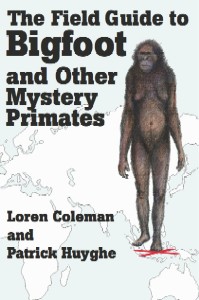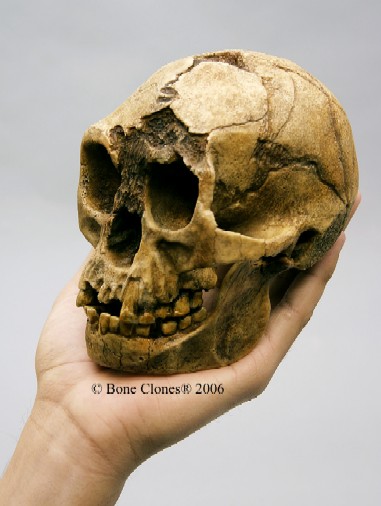Where To Dig For Hobbits
Posted by: Loren Coleman on January 27th, 2007

What’s wrong with this drawing? (The answer is below.)
Homo floresiensis, the “Hobbits” of Indonesia have been in the news again lately.
This week it was announced that the dig will start up anew at the same cave where all the previous discoveries have been made on Flores.
First, a flashback: How important and significant is the discovery of this species to cryptozoology? The editor of Nature, Henry Gee, in a 2004 editorial entitled “Flores, God and Cryptozoology,” wrote:
The discovery that Homo floresiensis survived until so very recently, in geological terms, makes it more likely that stories of other mythical, human-like creatures such as Yetis are founded on grains of truth….Now, cryptozoology, the study of such fabulous creatures, can come in from the cold.Henry Gee
Now the discoverers are going back to look for more, after being blocked from doing so.
Professor Richard “Bert” Roberts, from the University of Wollongong in Australia, a member of the team that found the specimens, told BBC News:
This year we will back in Liang Bua again, back in the cave where we found the Hobbits. This is good; we’ve now managed to get over the political hurdles that had been put up. We’ll probably be in there towards the middle of the year.
It’s now a matter of getting everything organized so we can start digging again. You’ve got to get there in the dry season; in the wet season you can hardly drive to the site and when you are there, there are puddles of water all over the floor – so it’s got to be dry to sensibly dig holes.Professor Richard “Bert” Roberts
Mike Morwood, director of the excavation, also told BBC News the remains at Liang Bua could be the tip of the iceberg:
South-East Asia and East Asia are going to yield an awful lot of surprises and it’s going to make a major contribution to our understanding of hominin evolution.
This particular discovery seems to have prompted people to rethink what it is to be human, the relationship between brain size and behaviour, and whether hominin populations have been insulated from environmental factors. This indicates that they haven’t.
It also raises questions about the colonisation capabilities of early hominids. What are they doing on Flores and what are they almost certainly doing on other islands in South-East Asia.Mike Morwood
As I wrote in 2004, one way to investigate further future sites to look for evidence of Homo floresiensis is to search out and listen to the stories about little people. But that time is not coming soon, as it is back to Liang Bua first, for now.
When discussing the announced discovery of Homo floresiensis as one of the top stories of 2004, I wrote:
Local natives on Flores have one hundred year old legends of a small hairy people, the Ebu Gogo, and clues from these tales will be employed to find new caves to explore for evidence of their former little habitants. While Sumatra’s Orang Pendek has been mentioned in the same context as the media nicknamed ‘Hobbits’ of Flores, the more relevant cryptids are not anthropoids, but the fully manlike ones, such as the Nittaewo, the three feet tall hairy hominids of ancient Ceylon (Sri Lanka) — mentioned by Pliny in the first century — who were said to exist to the end of the 18th Century. It is time to look again at reports of little people, with an eye to the discovery of their subfossil remains and living existence, from Sri Lanka to the South Pacific.Loren Coleman
National Geographic’s representation (at top) of Homo floresiensis, a “Hobbit” is incorrect. Why? Well, for starters, the first type specimen is not shown well above because LB1 was not a male specimen. They also may have been hairier. Richard Klyver’s drawing (below) of a female H. floresiensis may be much closer to how she appeared.

This interpretation of the Flores woman, Homo floresiensis, by wildlife artist Richard Klyver, is based on the Australian and Indonesian discovery combined with my cryptozoology research on recent evidence, such as the sightings and folklore of Asia’s unknown hominoids. The drawing of the LB1 female is shown standing on a map with a red X marking Flores, from the cover of The Field Guide to Bigfoot and Other Mystery Primates by Loren Coleman and Patrick Huyghe.

Even you can own an important part of cryptozoological and anthropological history, the Bone Clones’ Homo floresiensis skull replica.

Orders for the Bone Clones reproduction can be made by going to the Bone Clones ordering information here.
About Loren Coleman
Loren Coleman is one of the world’s leading cryptozoologists, some say “the” leading living cryptozoologist. Certainly, he is acknowledged as the current living American researcher and writer who has most popularized cryptozoology in the late 20th and early 21st centuries.
Starting his fieldwork and investigations in 1960, after traveling and trekking extensively in pursuit of cryptozoological mysteries, Coleman began writing to share his experiences in 1969. An honorary member of Ivan T. Sanderson’s Society for the Investigation of the Unexplained in the 1970s, Coleman has been bestowed with similar honorary memberships of the North Idaho College Cryptozoology Club in 1983, and in subsequent years, that of the British Columbia Scientific Cryptozoology Club, CryptoSafari International, and other international organizations. He was also a Life Member and Benefactor of the International Society of Cryptozoology (now-defunct).
Loren Coleman’s daily blog, as a member of the Cryptomundo Team, served as an ongoing avenue of communication for the ever-growing body of cryptozoo news from 2005 through 2013. He returned as an infrequent contributor beginning Halloween week of 2015.
Coleman is the founder in 2003, and current director of the International Cryptozoology Museum in Portland, Maine.










Glad they are going back to Flores- hopefully they will find more evidence to help clear up what exactly this creature is.
And Loren is right- the strong local legends and isolation of the south east Asian islands make them prime hunting ground for finding new hominid species/subspecies. And maybe some of them will still be alive.
This article also reinforces what I posted earlier today with regards to the ‘digging for proof of sasquatch’ story- if we are going to find any hard evidence for bigfoot we could do much worse than start excavating some caves and rockshelters.
(Of course, I mean we could do much worse than getting some qualified archaeologists to excavate some caves- we don’t want to go destroying or damaging one of the few things that might prove our case!)
I agree with things-in-the-woods. It is a very logical and solid first step towards uncovering remains of the creature by starting to search the caves. It is reasonable to think that if there is fossil evidence to be found, then that is going to be the place to find it. I too hope that the real identity of the Flores hobbit acquires more evidence. Right now there seems to be just as much debate about it as there is about sasquatch!
I find it curious just how disturbing many seem to find the idea that we may now or may have in the past shared our planet with other possibly intelligent beings, or with near relatives that might possibly be considered human in the long run.
I’m not saying that those who write here are in that category, but it seems a fairly common trait in those raised in our culture.
Curiously enough, I’ve just been reading up about the Surem, a race of tiny magical humanoids the Yaqui Indians believe themselves to be descended from; and I find it very striking not only how old and widespread around the world this whole belief is, but also how prevalent is its companion notion that these miniature races have continued secretly persisting right up to the present day.
When you put that idea together with such interesting anthropological tidbits as the likes of the Sumerians, the Ancient Egyptians, and the Ancient South American peoples reverenced ‘dwarfs/dwarves’ to the point of having some of them for gods, one starts wondering what might be found if people actually started looking for traces of these miniature races; or, for that matter, what might have been lost, or even possibly merely mislaid, because someone decided the traces of the peculiar little people they’d come across were merely random physical freaks.
This is exciting news. Anytime science correlates traditional cultural stories with hard scientific evidence, we all win. I truly hope the excavations are successful and result in additional remains to help us better understand who/what Flores Man is.
“I find it curious just how disturbing many seem to find the idea that we may now or may have in the past shared our planet with other possibly intelligent beings, or with near relatives that might possibly be considered human in the long run.
I’m not saying that those who write here are in that category, but it seems a fairly common trait in those raised in our culture. ”
That may be because our culture has been so good at dehumanizing members of our own species. Heck, a hundred years ago, some people were still debating how “Human” Africans and Native Americans were! Despite all the progress we’ve experienced since then, undercurrents of such ugliness remain. If people are still suspicious of the “otherness” of members of their own species, how much more disturbing must they find the seeming “Human-ness” of an anthropoidal ape?
It also flies in the face of the oh-so-cherished religious concept that Humans are somehow not animals, nor subject to the same pressures and protocols as they are, but something altogether superior and exceptional, in much the way that they postulate beings superior in every way to us- the angels, archangels, and so on. People cannot begin to accept a spectrum of Human-ness because such a notion is antithetical to their conception of reality. Their entire world view would shatter, the hierarchy crumble, and they would be left with more difficult questions to face. People cling to their narrow, black-and-white view of the world precisely because it is simple, and therefore easy to understand. There’s no need to think about it, to question, to wrestle with murky ethical quandaries over, say, when does an animal share enough traits with a person to be considered Human, and what rights should an animal have, even it it’s not on that same level?
I agree, it’s baffling to most all of us here, because in one way or another, we’re searchers, seekers of truth, and that means that above all, we are questioners. Doubt is more a friend to us than she is a nemesis.
Let me leave you with a few quotes of relevance-
“Men become more civilized not in proportion to their willingness to believe, but in proportion to their readiness to doubt.” -H. L. Mencken
“Who never doubted, never half believed. Where doubt is, there Truth is- it is her shadow.” -Gamaliel Baile
“If a man will begin with certainties, he shall end in doubts; but if he will be content to begin with doubts he shall end in certainties.” -Francis Bacon